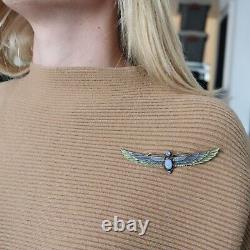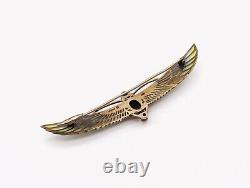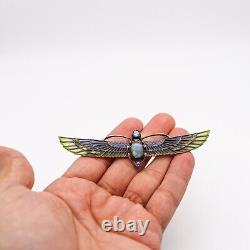Austrian 1915 Art Nouveau Egyptian Revival Plique à Jour Winged Scarab Brooch








An exceptional elongated brooch, created in Austria during the art. This magnifique piece has been carefully crafted with the. 999 silver with brushed finish. The wings are accented with applications of the difficult technique of. Fitted at the reverse with a hinged horizontal bar with a security lock. The figure represent the Egyptian sacred scarab with open feathers wings, of the god Khepri. Quartz Stones: Mount in bezel settings, with 2 round cut of blue quartz. Opal : Mount in a bezel setting, with 1 oval cabochon cut of a natural opal of about 2.75 carats. Weight : 17.95 Grams, (11.50 Dwt).
Measurements : 108 mm by 26 mm (4.25 x 1.02 Inches). Hallmarks : Stamped with the maker's mark inside a circle, the mark for the assay of the silver and signed. This kind of beetle was highly symbolic to ancient Egyptians, it represented rebirth and renewal. They believed that the sun was pushed across the sky every day by a giant scarab, the god Khepri.
In real life, the scarab beetle lays its eggs in a ball of dung and rolls the ball ahead of it wherever it goes. A scarab is shaped like a dung beetle. There is a head, wing case, and legs. It is sometimes rounded and sometimes flat.
The scarab was associated with the god Khepri who was the god or rebirth, creation, and the sun. Dung beetles were the earthly personification of Khepri as they would lay their eggs in balls of dung and then roll the dung balls all around until the eggs hatched. Early hieroglyphics depict Khepri as a scarab holding up the sun. There were hundreds of memorial scarabs created to memorialize Amenhotep III's deeds. These included the bull hunt scarab which symbolizes strength and victory over chaos.Later, around 2000 BCE the scarab was used in jewelry and as seals. The amulets were worn as protection against the dangers of this world and the afterlife.
The scarab represented the sun god Ra that rolled across the sky each day. Between the 16th and 11th- century heart scarabs were created to be placed on a mummy's heart. When a person reached the afterlife their heart was weighed by the goddess of truth. If the heart was heavy with sin they could not move forward to the afterlife.
The heart scarab would convince the gods that the person was trustworthy and should move into the afterlife without having their heart weighed. Other heart scarabs were used as general protection to the afterlife. For centuries, Ancient Egypt has held the fascination of the public and continues to inspire artists and designers alike.Between the 1860 and 1890, ancient cities were discovered, such as Troy, Pompeii and Alexandria. Archaeological excavations in Egypt, Greece and Rome, discovered artistic pieces of these ancient cultures.
These fabulous discoveries, stimulated cultural trips to these countries, popularly called. Being the case that the enthusiast visitors bring back small objects, like souvenirs to be assembled into jewelry.
The starting point of these trips were in the cities of Rome and Venice. Jewelry was created in France between about 1895 and 1910, coming on the heels of the "overwrought" designs of the Victorian era (which ended with Queen Victoria's death in 1901) and creating a striking contrast to the mainstream Edwardian designs of that time. While jewelry with a similar aesthetic was being made in other countries during the same time period--for example, Jugendstil in Germany and Austria--true Art Nouveau jewelry is decidedly extended in France.
It was a short-lived period in jewelry design, lasting only about 15 years, because of the onset of World War I and because the pieces were so over-the-top that people quickly lost interest in them. Characterised by lavish and organic ornamentation, the Art Nouveau movement blossomed in Vienna at the turn of the 20th Century, with influential Austrians architects Otto Wagner and Adolf Loos making significant architectural contributions that helped shape the city's skyline as we see it today. Rene Lalique, was the most celebrated art nouveau designer, championed jewelry designer. Derivate from the French is "letting in daylight". Is a very difficult vitreous enamelling technique where the enamel is applied in cells, similar to cloisonné, but with no backing in the final product, so light can shine through the transparent or translucent enamel.It is in effect a miniature version of stained-glass and is considered very challenging technically: high time consumption (up to 4 months per item), with a high failure rate. The technique is similar to that of cloisonné, but using a temporary backing that after firing is dissolved by acid or rubbed away.
A different technique relies solely on surface tension, for smaller areas. In Japan the technique is known as shotai-jippo (shotai shippo), and is found from the 19th century on. Collateral : This brooch is accompanied by a presentation jewelry box.
Condition : The overall condition of this brooch is excellent. Beside the little normal wear, there is no damage to the silver. The enamel and the gems are secured in the settings. This piece has been carefully inspected to guarantee the condition and authenticity. This item is in the category "Jewelry & Watches\Vintage & Antique Jewelry\Brooches & Pins". The seller is "treasurefinejewelry" and is located in this country: US. This item can be shipped to United States, Canada.- Antique: Yes
- Shape: EGYPTIAN
- Occasion: ANY
- Year Manufactured: Pre-1920
- Main Stone Color: OPAL
- Metal: SILVER .900
- Item Length: 4.25 INCHES
- Secondary Stone: PLIQUE A JOUR ENAMEL
- Jewelry Department: Fine
- Vintage: No
- Main Stone: Black Opal
- Department: Unisex Adults
- Main Stone Shape: OVAL CABOCHON
- Gemstone Clarity Grade: Eye Clean
- Base Metal: Sterling Silver
- Features: STEM PIN
- Number of Gemstones: 1
- Handmade: Yes
- Main Stone Creation: Natural
- Seller Warranty: Yes
- Signed: Yes
- Cut Grade: Excellent
- Color: Multicolor
- Material: SILVER AND OPAL
- Total Carat Weight: 2.75 carats
- Setting Style: Bezel
- Brand: EGYPTIAN REVIVAL
- Type: Brooch
- Era: EGYPTIAN REVIVAL ART NOUVEAU
- Customized: No
- Original/Reproduction: Original
- Theme: P021023MSNM/.5321
- Country/Region of Manufacture: Austria
- Wholesale: No
- Country of Origin: Austria

